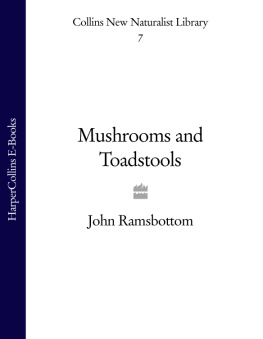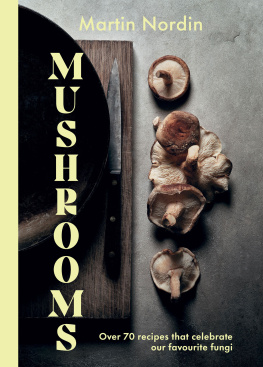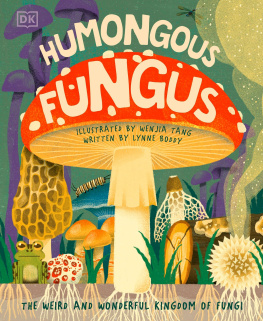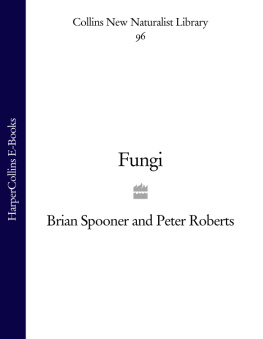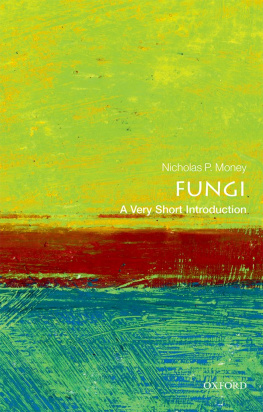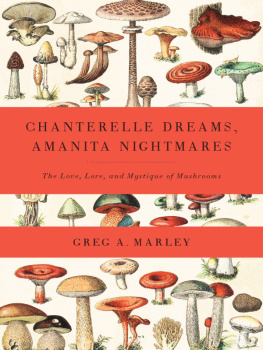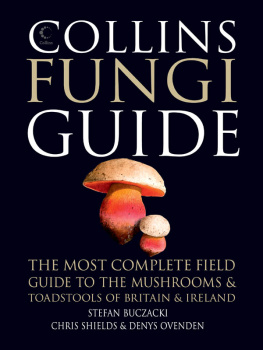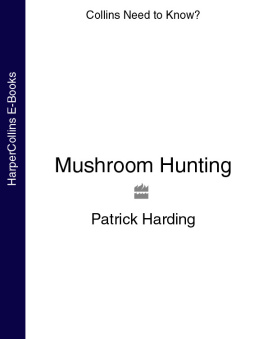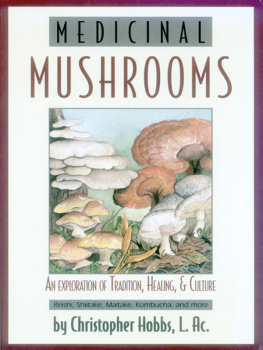John Ramsbottom - Mushrooms and Toadstools: A Study of the Activities of Fungi
Here you can read online John Ramsbottom - Mushrooms and Toadstools: A Study of the Activities of Fungi full text of the book (entire story) in english for free. Download pdf and epub, get meaning, cover and reviews about this ebook. year: 2009, publisher: Collins, genre: Religion. Description of the work, (preface) as well as reviews are available. Best literature library LitArk.com created for fans of good reading and offers a wide selection of genres:
Romance novel
Science fiction
Adventure
Detective
Science
History
Home and family
Prose
Art
Politics
Computer
Non-fiction
Religion
Business
Children
Humor
Choose a favorite category and find really read worthwhile books. Enjoy immersion in the world of imagination, feel the emotions of the characters or learn something new for yourself, make an fascinating discovery.
- Book:Mushrooms and Toadstools: A Study of the Activities of Fungi
- Author:
- Publisher:Collins
- Genre:
- Year:2009
- Rating:4 / 5
- Favourites:Add to favourites
- Your mark:
- 80
- 1
- 2
- 3
- 4
- 5
Mushrooms and Toadstools: A Study of the Activities of Fungi: summary, description and annotation
We offer to read an annotation, description, summary or preface (depends on what the author of the book "Mushrooms and Toadstools: A Study of the Activities of Fungi" wrote himself). If you haven't found the necessary information about the book — write in the comments, we will try to find it.
Mushrooms and Toadstools: A Study of the Activities of Fungi — read online for free the complete book (whole text) full work
Below is the text of the book, divided by pages. System saving the place of the last page read, allows you to conveniently read the book "Mushrooms and Toadstools: A Study of the Activities of Fungi" online for free, without having to search again every time where you left off. Put a bookmark, and you can go to the page where you finished reading at any time.
Font size:
Interval:
Bookmark:

JAMES FISHER M.A.
JOHN GILMOUR M.A.
JULIAN S. HUXLEY M.A. D.Sc. F.R.S.
L. DUDLEY STAMP B.A. D.Sc.
PHOTOGRAPHIC EDITOR:
ERIC HOSKING F.R.P.S.
The aim of this series is to interest the general reader in the wild life of Britain by recapturing the inquiring spirit of the old naturalist. The Editors believe that the natural pride of the British public in the native fauna and flora, to which must be added concern for their conservation, are best fostered by maintaining a high standard of accuracy combined with clarity of exposition in presenting the results of modern scientific research. The plants and animals are described in relation to their homes and habitats and are portrayed in the full beauty of their natural colours, by the latest methods of colour photography and reproduction.
TO FORMER COLLEAGUES
BRITISH MUSEUM (NATURAL HISTORY)
19101950
In Friendship
WITHOUT DOUBT, no one is better qualified to write a book on British Fungi than Dr. John Ramsbottom. The present long-awaited addition to the New Naturalist Series contains the distilled harvest of a life-times knowledge and experience, much of it, especially in the historical field, never before published in accessible form. We say distilled advisably, since Dr. Ramsbottom could undoubtedly have writtenin fact, did, in the first place, writea book of more than double the present length; and, even then, he complained that much had to be omitted!
Dr. Ramsbottom has recently retired after forty years service in the Department of Botany at the Natural History Museum, South Kensington, having been Keeper of Botany during the last twenty years. As his book shows, however, he is far from being a purely museum botanist. Every aspect of Fungi has fascinated him, and he is equally at home hunting for rare toadstools in the Surrey woods, attending a conference in South America on medical mycology, ransacking old books for reference to the truffle-hunting habits of dogs, and probing the secrets of sex in moulds. He has always been willing to share his knowledge with others, and many will remember him best at his annual autumn exhibit of edible and poisonous toadstools at the Royal Horticultural Societys Shows, surrounded by crowds of eager questioners thrusting forward specimens for identification. The Editors feel fortunate in having persuaded Dr. Ramsbottom to put his unrivalled knowledge on permanent record as a volume in the New Naturalist Series.
The great group of Fungi, comprising perhaps some hundred thousand species, shows an amazing variety of form, from the minute unicellular yeasts to the Giant Puff-balls and bracket Fungi. The group touches human activities at a surprising number of points. In recent years everyone has become familiar with penicillin and other antibiotics produced from moulds, but how many fully appreciate the role of Fungi in wine and beer making, in the diseases of both plants and animals (including man), and as a human food throughout the world? Dr. Ramsbottom has not, of course, been able to deal in detail with all these aspects of Fungi; he has concentrated mainly on the larger kinds, commonly known as toadstools; but he has touched on most groups, and has a final chapter describing fully the story of the development of the penicillin industry from its beginnings in Sir Alexander Flemings room at St. Marys Hospital. This is the best short account of penicillin that has been written, in our opinion.
Dr. Ramsbottom, as will be seen, has paid particular attention to the history of Fungi, their names, their uses, and the beliefs and superstitions connected with them, as revealed in old books. The abundant quotations and references he has brought together can be found in no other book and give a special value to his volume. In his chapter on mushroom-growing, too, he has gathered together a mass of obscure information, including particulars of the vast cave industry under the streets of Paris.
Parts of Dr. Ramsbottoms book will be found to be more technical than the majority of New Naturalist volumes. When writing of Fungi this is inevitable. Very few species have English names, and when describing, for example, the sexual behaviour of the lower Fungi, it is impossible to avoid using technical language. With the help of the glossary-index, however, any reader should be able to understand these sections if he is willing to take the necessary trouble.
This volume is not, of course, intended as a handbook for the identification of British toadstools. Excellent books for this purpose already exist. In several chapters, however, Dr. Ramsbottom has given lists of the species occurring in different types of habitat, together with mention of their main distinguishing characters.
The book is fully illustrated with black and white and with colour plates, and the fine photographs by Mr. de Laszlo do full justice, we feel, to the fascinating colour scheme affected by so many kinds of toadstool.
The Editors, during the production of this book, have come to look upon Dr. Ramsbottom as a sort of Robert Burton of the fungal world, and, with his discursive style, curious learning, and wide canvas, he has, we feel, given us something approaching a twentieth century Anatomy of Toadstools.
THE EDITORS
THE WRITING OF THIS BOOK has presented several problems, chief of which has been that of giving a sufficiently wide view of the subject in a single volume. It seemed desirable to try to explain the modes of life of this large group, the fungi, and this in its turn meant suggesting its biological relations to other groups of organisms.
The fact had also to be faced that probably only about half a dozen of the larger fungi are recognised by people generally; and consequently there are surprisingly few common names. Names alone, therefore, are likely to mean nothing to the general reader, except irritation, so some indication of what they signify is needed. Unfortunately lack of space has prevented this being done in any detail, but the colour plates will help to determine a number of species, or give an idea of those mentioned in the text.
Doubtless others would have treated the subject differently: but having always been impressed with the influence fungi have on our very existence, I wished to convey some idea of this. Those who specialise in any branch of knowledge naturally tend to magnify its importancebut a mycologist, if he regards fungi as living organisms, can hardly fail to realise the significance of other disciplines. On the other hand scientists generally are beginning to consider that the old-time neglect of fungieven by botanistswas short-sighted.
The writing of the book has taken far longer than I expected, and when first written greatly exceeded the required length! To preserve some sort of balance meant the cutting out of some portions (which probably will be published elsewhere) and the cutting down of others. The result is, however, somewhat uneven: the chapters on Grasslands (17) and Woodlands (19) are but shadows of their former selves; though what is little more than a list of species should serve as an introduction to their descriptions in systematic works. There is abundant scope for original observations, but it must be stressed that these can have no scientific value without correct identifications. The Penicillin chapter was included at the request of the Editors.
As far as possible scientific terms have been kept to a minimum and all except those which are explained are to be found in standard dictionaries. Difficile est de scientiis inscientur loqui; which is as much
After this apologia there remains the pleasure of thanking those who have been of help. It is not possible to list all those to whom I am under obligation; for it has been my good fortune to be in close touch with amateur and professional mycologists, both here and abroad, for many yearsand as Linnaeus remarked, Sometimes a blind hen meets with a grain of corn, and I must have gleaned.
Font size:
Interval:
Bookmark:
Similar books «Mushrooms and Toadstools: A Study of the Activities of Fungi»
Look at similar books to Mushrooms and Toadstools: A Study of the Activities of Fungi. We have selected literature similar in name and meaning in the hope of providing readers with more options to find new, interesting, not yet read works.
Discussion, reviews of the book Mushrooms and Toadstools: A Study of the Activities of Fungi and just readers' own opinions. Leave your comments, write what you think about the work, its meaning or the main characters. Specify what exactly you liked and what you didn't like, and why you think so.

